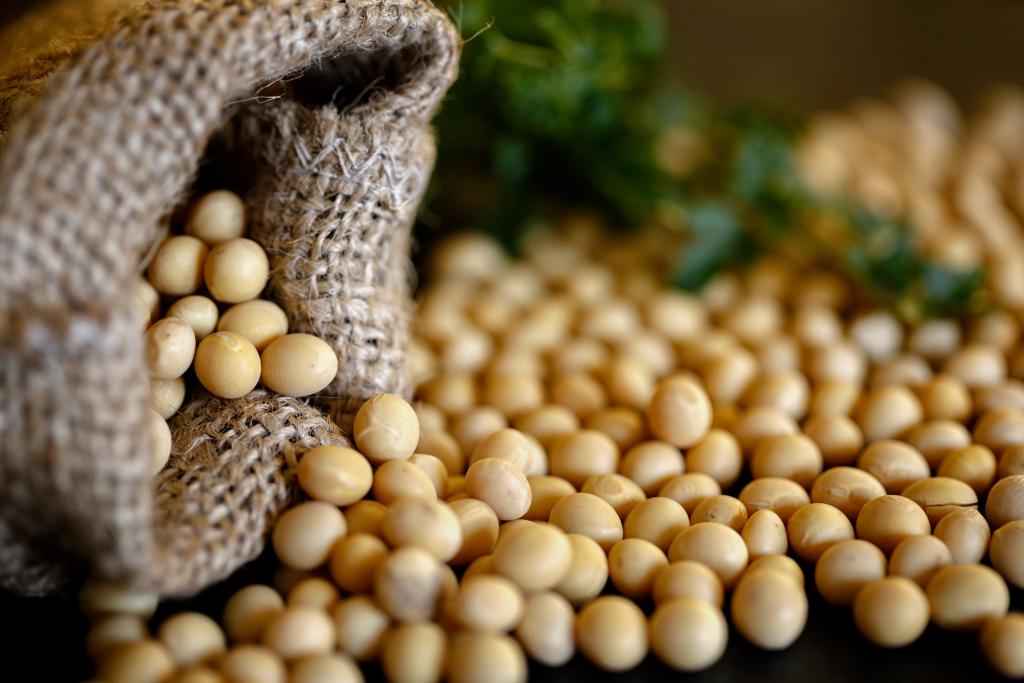Soybean Insights: Market Trends and Projections
In the realm of us soybean trading, May delivery futures have slumps by 13.25¢, reaching $11.45¼ per bushel. Concurrently, soymeal experienced a dip of $3.2 to $335.80 per short ton, while soy oil displayed resilience, slumps 0.56¢ to reach 44.94¢ per pound.
|
Soybean |
||||||
|
Contract |
Last |
Change |
Open |
High |
Low |
Close |
|
24-May |
11.45 |
-13.25 |
11.5725 |
11.63 |
11.4325 |
11.4525 |
|
24-Jul |
11.6 |
-12 |
11.715 |
11.7725 |
11.58 |
11.6 |
|
24-Aug |
11.6075 |
-10.75 |
11.69 |
11.765 |
11.5875 |
11.605 |
|
Soybean Oil |
||||||
|
Contract |
Last |
Change |
Open |
High |
Low |
Close |
|
24-May |
0.4491 |
-0.56 |
0.454 |
0.4544 |
0.4457 |
0.4494 |
|
24-Jul |
0.4548 |
-0.53 |
0.4595 |
0.4599 |
0.4512 |
0.4549 |
|
24-Aug |
0.4569 |
-0.53 |
0.4611 |
0.462 |
0.4537 |
0.457 |
|
Soybean Meal |
||||||
|
Contract |
Last |
Change |
Open |
High |
Low |
Close |
|
24-May |
3.353 |
-3.2 |
3.386 |
3.415 |
3.352 |
3.356 |
|
24-Jul |
3.368 |
-2.8 |
3.397 |
3.418 |
3.365 |
3.368 |
|
24-Aug |
3.373 |
-2.9 |
3.402 |
3.421 |
3.372 |
3.374 |
|
By Abdul Hameed Team |
||||||
Click Here To View April 15, 2024 Report
Soybean Planting in USA Signals Growth in Agricultural Activity
- Soybean Planting Activity
In recent overnight trading, soybean and grain futures experienced a modest downturn. This trend coincides with the ongoing harvest in Brazil and the initiation of planting activities in the United States.
- Brazilian Soybean Harvest Update
As of April 11, the soybean harvest in Brazil, the world’s leading exporter of soybeans, reached completion on 84% of the projected area. a prominent consultancy, released this data in its recent report. Despite the progress, agricultural meteorologist Don Keeney from Maxar noted that rainfall earlier in the week may have temporarily slowed down crop collection efforts.
- US Planting Progress
In the United States, planting activities have commenced, with 6% of corn and 3% of soybeans already sown as of Sunday, according to the Department of Agriculture. This marks an improvement compared to the same period last year, indicating an early start to the planting season.
Insights into US Agricultural Activity
- Increased Soybean Planting in the USA
Last week, farmers in the United States initiated soybean planting activities. According to the latest USDA crop tour data as of April 14, 3% of the intended soybean acreage has been sown, surpassing the five-year average of 1%.
- Impact on Soybean Prices
Market analyst Kluis highlights the significance of soybean crush reports, emphasizing the positive implications of increased crush pace on soybean prices in the long term. The National Oilseed Processors Association (NOPA) recently reported a record soybean crush for March, signaling heightened demand. However, the report’s discrepancy from trade expectations momentarily influenced prices negatively.
Brazilian Soybean Harvest Progress
As of April 11, Brazilian farmers had completed soybean harvesting on 84% of the planned area, slightly lower than the previous year’s progress. Noteworthy advancements were observed in the northeastern states of Bahia and Piaui, along with Rio Grande do Sul, where farmers hastened harvesting ahead of anticipated heavy rainfall.
- Production Forecasts and Market Trends
Despite challenges, production forecasts for soybeans in Brazil remain optimistic. Conab Agency predicts a 68% increase in soybean production in Rio Grande do Sul, positioning the state as the second-largest producer after Mato Grosso. However, low soybean prices have led to reduced sales, with only 16% of the harvest sold thus far.
Global Oilseed Market Outlook
Challenges in US Soybean Exports
The United States faced challenges in meeting soybean export targets for the 2023/24 marketing year, falling short of USDA projections. This shortfall, coupled with a decline in exports from Ukraine, exerts downward pressure on soybean prices.
- Forecast for Ukrainian Oilseed Production
Ukrainian oilseed production for the 2024/25 marketing year is projected to decrease slightly compared to the current season. While soybean production is expected to rise, sunflower and rapeseed production may decline, reflecting dynamic shifts in crop cultivation patterns.
Taiwan’s Soybean Imports Set to Surge Amidst Rebounding Feed Demand
Taiwan’s soybean import forecast sees a significant uptick amidst a rebounding feed demand, according to a recent report by the USDA’s Foreign Agricultural Service (FAS). Here’s a breakdown of the key insights and projections:
- Production Challenges and Growth Trajectory
Taiwan’s soybean production remains minimal, hovering around 6,000 tons, owing to factors such as the dominance of rice and other crops, limited available farmland, and import competitiveness. Despite these challenges, production has experienced a gradual rise from near zero in 2012.
- Obstacles and Logistics
However, Taiwan faces hurdles in its soybean import landscape. The report highlights logistical challenges encountered in the first half of the current marketing year, particularly in the Panama Canal and the Red Sea region, which hindered bulk supplies from the U.S., a major soybean supplier.
Thailand’s Soybean Crush Projections
Shifting focus to Thailand, the report indicates a projected 2% growth in soybean crush for the 2023-24 period, followed by a 3% increase in 2024-25. While pre-pandemic trends showcased a five-year annual growth rate of approximately 5%, the slow recovery in domestic consumption of soybean oil and soybean meal for swine feed post-COVID-19 has dampened growth forecasts.
- Thailand’s Import Trends and Crush Capacity
Annual soybean production in Thailand remains marginal, ranging between 50,000 to 60,000 tonnes, with imports primarily sourced from Brazil. Crush projections for 2024-25 indicate an increase to 2.43 million tonnes, with imports expected to reach 3.3 million tonnes, a slight rise from the previous year. Notably, approximately 70% of soybeans in Thailand are crushed for cooking oil, with soybean meal serving as a crucial component in animal feed production.
Challenges in Canada’s Canola Crush Expansion
Canada’s canola crush expansion faces hurdles, reports the U.S. Department of Agriculture.
- Slow Progress in Canola Crushing Capacity
The U.S. Department of Agriculture’s Foreign Agricultural Service (FAS) recently highlighted delays in canola crush expansion projects, slowing the anticipated growth in capacity. These delays, spanning from 2023 to 2025, have hindered the pace of capacity enhancement.
- Projections and Potential Setbacks
Despite the setbacks, the FAS projects a gradual increase in capacity, estimating it to reach 10.26 million tonnes by mid-2024 and 11.26 million tonnes by the end of 2025.
In conclusion, the soybean market’s intricacies reflect a delicate dance of supply, demand, and global dynamics. As we navigate these fluctuations, staying attuned to market trends and agricultural forecasts is paramount across the supply chain. So we are predicting that soybean market project a Bearish trend Projections and as well in hovering within the range of $11.0 to $12.0 per bushel.


